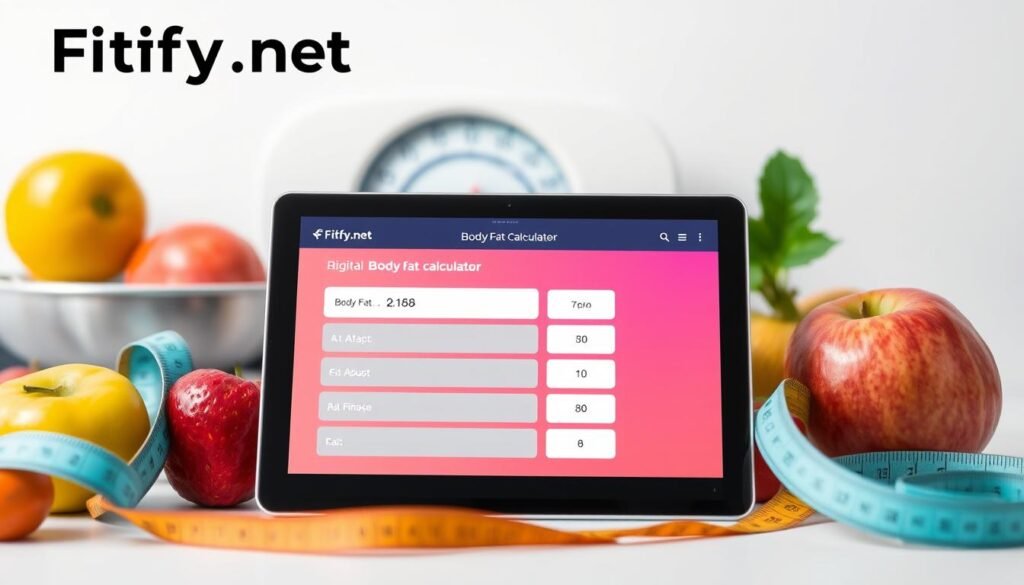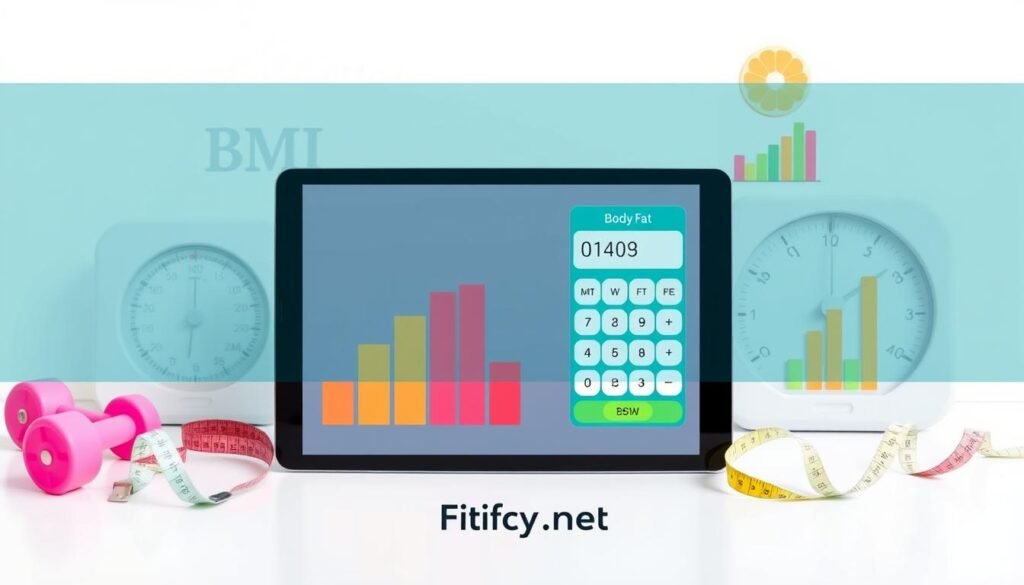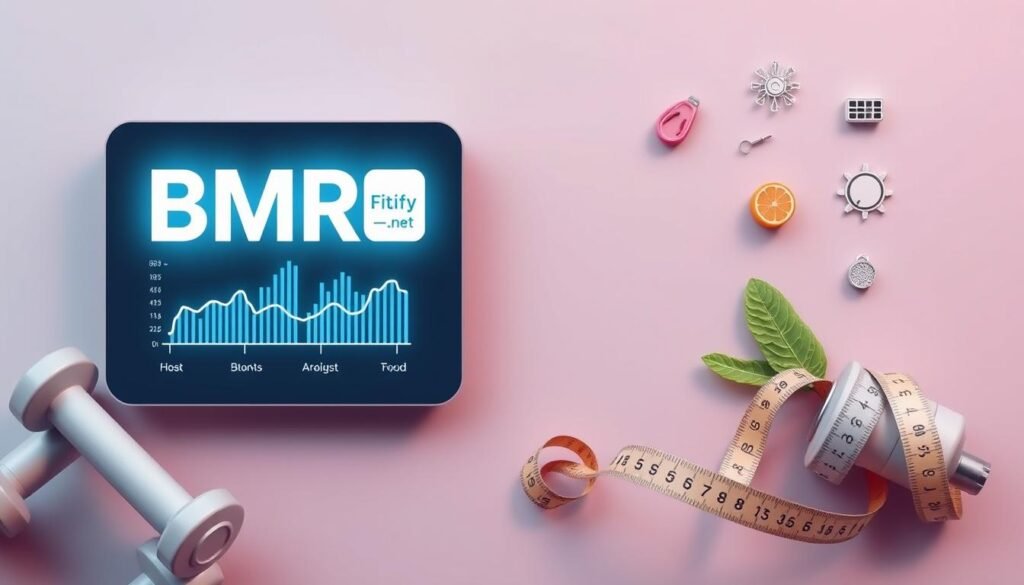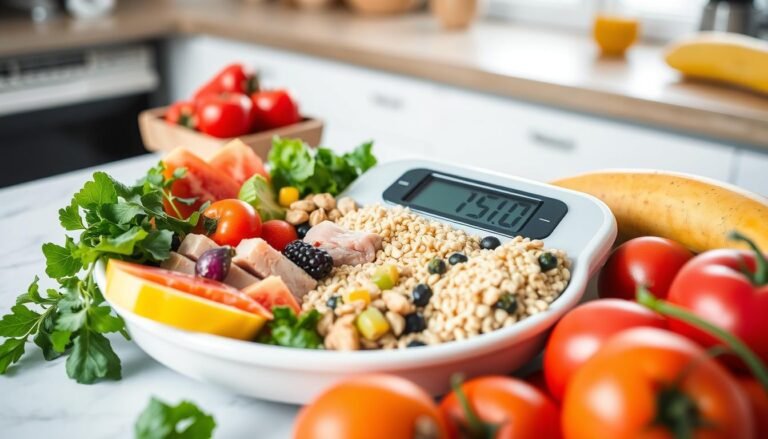The Body Fat Calculator is a powerful online tool. It helps users find their body fat percentage and Body Mass Index (BMI) quickly. Just enter your gender, age, weight, and height to get results.
These results are tailored to help you track your health and fitness. They also guide you towards your weight loss and wellness goals. This calculator is perfect for anyone, whether you’re just starting or already living a healthy lifestyle.

Key Takeaways
- The Body Fat Calculator provides a comprehensive assessment of body composition, including body fat percentage and BMI.
- Users can input their gender, age, weight, and height to receive personalized results and track their progress over time.
- The Body Fat calculator is suitable for individuals of all fitness levels, from those just starting their weight loss journey to those maintaining a healthy lifestyle.
- Monitoring body fat percentage and BMI can help users set realistic weight loss goals and make informed decisions about their diet and exercise routines.
- Incorporating the Body Fat Calculator into a comprehensive weight management plan can lead to sustainable, long-term results.
Understanding Body Fat Percentage and Its Importance
Keeping a healthy body fat percentage is key for your well-being. It shows how much fat you have in your body. Knowing the types of body fat and the right amounts for your age and gender helps you set good fitness goals.
Different Types of Body Fat
There are three main types of body fat: essential, subcutaneous, and visceral. Essential fat is needed for your body’s functions and hormone production. It makes up 2-5% of total body fat in men and 10-13% in women.
Subcutaneous fat is the fat just under your skin and is easy to see. Visceral fat, however, is deep inside and wraps around your organs. It’s linked to more health risks.
Health Implications of Body Fat Levels
Too much body fat, especially visceral fat, can cause health problems. Obesity is a big issue, with 36.5% of U.S. adults being obese. High visceral fat raises the risk of heart disease, insulin resistance, and type 2 diabetes.
Ideal Body Fat Ranges by Age and Gender
The healthy body fat range for men is 8-19%. For women, it’s 21-33%. Athletes usually have body fat between 14-20% for women and 6-13% for men. Fitness individuals have body fat between 21-24% for women and 14-17% for men. Being obese is defined as having more than 32% body fat for women and 25% for men.
“Maintaining a healthy body fat percentage is crucial for overall well-being and longevity.”
How the Fat Calculator for Weight Loss Works
The fat calculator for weight loss is a helpful tool for tracking body fat percentage. It helps users see how close they are to their weight loss goals. It uses age, gender, weight, height, and activity level to estimate body fat percentage.
Some weight loss trackers also ask for waist, neck, and hip measurements. These extra details help get a more accurate body fat percentage. The calculator then uses these numbers to show the user’s body fat percentage. This lets users see their body composition and track their progress.
Using the fat calculator for weight loss regularly gives users important insights. It helps them make better choices about diet and exercise. This is especially helpful for those trying to lose weight, as it shows more than just weight.
Discover Your Fitness Blueprint! 🎯 Try our Body Composition Calculator now and unlock insights to achieve your health goals. Don’t wait—start today! 💪 Try it here.
| Input Parameter | Description |
|---|---|
| Age | The user’s age, typically ranging from 18 to 80 years old. |
| Gender | The user’s biological sex, which is a crucial factor in determining ideal body fat ranges. |
| Weight | The user’s current weight, which is used in conjunction with height to calculate body mass index (BMI). |
| Height | The user’s height, which is also used in the BMI calculation. |
| Physical Activity Level | The user’s overall physical activity level, ranging from sedentary to highly active, which affects caloric needs and metabolism. |
The fat calculator for weight loss uses different inputs to give a full picture of body composition. It also helps users track their progress over time.
Essential Measurements for Accurate Body Fat Calculation
Getting your body fat percentage right is key for managing weight and setting fitness goals. To get accurate results, you need to take a few important measurements. Let’s look at what you should measure.
Height and Weight Measurements
First, you need to measure your height and weight correctly. Make sure to use the same units every time, like pounds and feet or kilograms and centimeters. Keeping your measurements consistent helps you see how you’re doing over time.
Body Circumference Guidelines
Body fat calculators also use measurements around your body. These include your waist, hip, and neck. It’s important to follow the right steps for these measurements to get reliable results.
Additional Metrics for Precision
Some calculators might ask for more details, like skinfold measurements or bioelectrical impedance analysis. These can give you a better look at your body’s makeup. But, they might need special tools or skills. Think about what’s more important to you: easy access or detailed accuracy.
Getting your body measurements right is the first step to knowing your body fat accurately. By keeping track of your height, weight, and body circumference, you can see how you’re doing. This helps you as a weight management tool and fitness goal setter.
Integrating BMI and Body Fat Calculations
Body mass index (BMI) and body fat percentage are different but can work together. BMI uses your height and weight to show your body fat level. But it doesn’t consider muscle or fat placement.
Using BMI with body fat calculations gives a deeper look at your health and fitness. It helps set personal goals and track progress. Knowing both your BMI and body fat percentage helps you understand your body better and make smarter choices for your health.
Healthy Weight Ranges
For women, a good body fat percentage is 21 to 35 percent. Men should aim for 8 to 24 percent, based on age. These ranges come from the World Health Organization and the American College of Sports Medicine.
BMI suggests a healthy range of 18.5 to 24.9. But BMI doesn’t tell the whole story because it mixes fat and muscle. So, adding body fat percentage gives a clearer picture of your body.
Measurement Accuracy
There are many ways to measure body fat percentage, each with its own accuracy. The U.S. Navy Body Circumference method is about 3.5% accurate for most. The Covert Bailey Method is even more precise, at 2.0%.
Skinfold measurements with calipers are about 3.5% accurate. The Jackson-Pollock 3-Site Skinfold Method and 4-Site Skinfold Method are good for most people. But the Durnin-Womersley Skinfold Method might overestimate for very fit people.
By combining BMI and body fat percentage, you get a full view of your health and fitness. This sets the stage for better weight loss plans and lasting success.
Take Control of Your Health! 🧘♀️ Calculate your body composition in seconds and create a path to a fitter, healthier you. It’s free and easy! 🌟 Get Started.

Using the Calorie Counter App with Your Body Fat Results
Using a calorie counter app with your body fat results can help you reach your weight loss goals. These apps give you a better idea of how many calories you need each day. They take into account your body composition, how active you are, and what you want to achieve.
When you enter your body fat percentage and other details, the app gives you a personalized calorie count. Many apps also track your food, workouts, and how you’re doing over time. This helps you stick to a weight loss plan that really works.
Daily Caloric Needs Assessment
One big plus of using a calorie counter app is figuring out how many calories you should eat each day. These apps use smart formulas to guess your basal metabolic rate (BMR) and total calorie needs. They also consider your body fat percentage to give you a calorie count that fits your weight loss goals.
Tracking Progress Through Apps
- Calorie counter apps let you log your food, workouts, and weight. This way, you can see how you’re doing over time.
- Many apps connect with other health devices and apps. This gives you a full picture of your health and fitness journey.
- Tracking your calorie balance, macronutrients, and body fat changes helps you make smart choices about your diet and exercise.
Using a calorie counter app with your body fat results is a great way to lose weight. The app’s tools help you understand your calorie needs, track your progress, and adjust your plan as needed. This supports your journey to your ideal body.
Setting Realistic Weight Loss Goals with Body Measurements
Setting realistic weight loss goals is key for lasting success. Body measurements, like body fat percentage, give a fuller view of your progress than just weight. They help you set goals that fit your age, gender, body type, and health.
The safe and healthy rate of fat loss is 0.5-1% of your body weight each week. Using body measurements as a weight loss tracker helps you set and track realistic goals. This way, you lose fat while keeping muscle, which is good for your metabolism and fitness.
| Measurement | Recommended Rate of Loss |
|---|---|
| Body Weight | 0.5-1% per week |
| Body Fat Percentage | 0.5-1% per week |
Using body measurements in your fitness goal setter lets you understand your body better. This approach supports lasting progress and helps you reach your health goals.
“The key to successful weight loss is to set realistic goals and use body measurements to track your progress, not just the number on the scale.”
Macro Nutrient Calculator: Optimizing Your Diet Plan
Reaching your weight loss goals is more than just counting calories. It’s about finding the right mix of protein, carbs, and fats. A macro nutrient calculator is a great tool for this. It helps figure out the best macro ratios for you, making sure your diet helps you lose fat and keep muscle.
Protein Requirements for Weight Loss
Protein is key for keeping muscle while losing weight. The calculator looks at your body type, how active you are, and your weight loss goals. It tells you how much protein you need, helping you lose fat without losing muscle.
Carbohydrate and Fat Ratios
The calculator also guides you on carbs and fats in your diet. It considers your likes, activity level, and weight loss goals. It helps you find the right carbs and fats to fuel your workouts, boost energy, and keep you healthy.
With this calculator, you can make a diet plan that works for you. It helps you lose weight, build muscle, and keep your results. Use this powerful tool to take charge of your weight loss journey.
| Metric | Value |
|---|---|
| Macro Calculator Users | Millions |
| Average Weight Loss | 40+ lbs |
| Calorie Deficit Options | Mild, Moderate, Aggressive |
| Macro Ratio Default | 30% Fat, 0.65g Protein/lb, Remaining Carbs |
| Muscle Gain Surplus | 20% Calorie Increase |
The macro nutrient calculator has helped millions reach their fitness goals. It offers customizable options, tailored macro plans, and proven success. It’s a must-have for anyone wanting to improve their diet.
Understanding Your Basal Metabolic Rate (BMR)
Your basal metabolic rate (BMR) shows how many calories your body burns when you’re resting. It’s the energy needed for basic functions like breathing and organ work. Knowing your BMR helps you manage your weight by understanding your daily calorie needs.
BMR calculators use your age, gender, height, weight, and activity level to estimate your daily calories. This info is key for losing weight or keeping your current weight. Your muscle mass also affects your BMR, making it important to consider with your body fat percentage.
For example, a 35-year-old, 200-pound male burns 1,882 calories per day at rest. On the other hand, a 35-year-old female who weighs 150 pounds burns about 1,409 calories per day at rest.
The Mifflin-St. Jeor equation used in BMR calculators might be off by 10%. So, it’s wise to talk to a healthcare provider or registered dietitian. They can help create a plan that fits your health and nutrition goals.
Understanding your BMR helps you manage your weight by creating a calorie deficit. This way, you can lose weight or maintain it by optimizing your body’s energy use.
What’s Your Body Made Of? 🤔 Find out with our Body Composition Calculator. Perfect for setting realistic goals and tracking progress! 🚀 Check it out now.

“Increasing muscle mass can raise BMR, as muscle tissue is more metabolically active than fat.”
Tracking Progress: Weekly and Monthly Measurements
Tracking your body measurements is key to successful weight loss and weight management. By tracking your progress weekly and monthly, you can see how your efforts are working. You can also spot trends that might need changes to your diet or workout routine.
Recording Methods and Tools
There are many ways to track your body measurements. You can use mobile apps or even just a pen and paper. Some popular tools include:
- Dedicated weight loss tracker apps for logging weight and body fat
- Spreadsheets or digital journals for manual input
- Physical journals for tracking progress
Analyzing Trends and Adjusting Goals
It’s important to regularly analyze your body measurement data. Look for patterns in your weight and body fat changes. This helps you see if your diet and exercise are working.
- Check if your current plan is effective
- Determine if you need to change your calorie intake
- See if you’re losing weight at a healthy rate (1-2 pounds per week)
Remember, weight management is more than just the scale. Think about how you feel and your energy levels too.
| Metric | Weekly Average | Monthly Average |
|---|---|---|
| Weight | 2 lbs | 8 lbs |
| Body Fat Percentage | 0.5% | 2% |
| Waist Circumference | 1 inch | 4 inches |
By tracking your progress and adjusting your goals, you’ll reach your health and fitness goals.
Combining Exercise with Body Fat Monitoring
Regular exercise and body fat monitoring together are a strong way to reach your fitness goals. Whether you want to lose weight, build muscle, or improve your health, this combo is very helpful. Different exercises, like cardio and strength training, affect your body in different ways. Tracking your body fat helps you see how well your workouts are working.
Watching your body fat while exercising lets you tweak your routine for better results. Remember, gaining muscle can hide fat loss on the scale. So, body fat tracking is a better way to see your progress. This approach keeps you motivated and helps you make smart choices for your fitness goal setter and weight loss tracker goals.
Adding exercise and body fat tracking to your health plan makes it more complete and personal. By keeping an eye on your body composition and adjusting your workouts, you can get the best results. This way, you’ll feel more in control as you work towards your goals.
FAQ
What is the Body Fat Calculator?
The Body Fat Calculator is an online tool. It helps you find your body fat percentage and Body Mass Index (BMI). Just enter your gender, age, weight, and height to get your results. These results help you track your health and fitness goals.
Why is body fat percentage important?
Body fat percentage shows your health and fitness level. It tells you how much fat you have in your body. The right amount of fat varies by age and gender.
How does the fat calculator for weight loss work?
The fat calculator uses your age, gender, weight, height, and activity level to estimate your body fat. Some calculators also ask for waist, hip, and neck measurements. This helps give a more accurate body fat percentage.
What are the essential measurements for accurate body fat calculation?
To calculate body fat accurately, you need precise measurements. Use consistent units for height and weight. Waist, hip, and neck measurements are also important. Some tools may ask for more detailed measurements for better accuracy.
How do BMI and body fat percentage differ, and how can they be used together?
BMI and body fat percentage are different but can be used together. BMI uses height and weight to give a general idea of body fat. But it doesn’t consider muscle or fat distribution. Using both can give a better understanding of your health and fitness.
How can calorie counter apps be used with body fat calculations?
Calorie counter apps are useful with body fat calculations. They help figure out how many calories you need based on your body composition and activity level. By inputting your body fat percentage, you get a more accurate calorie count. These apps also track your food, exercise, and progress.
How can I set realistic weight loss goals using body measurements?
Setting realistic weight loss goals is key. Body measurements, like body fat percentage, give a better picture of progress than weight alone. Consider your age, gender, body composition, and health when setting goals. Aim to lose 0.5-1% of body weight per week for a healthy pace.
How does a macro nutrient calculator help with weight loss?
A macro nutrient calculator helps find the right balance of proteins, carbs, and fats for your diet. For weight loss, you need more protein to keep muscle. It suggests the right carbs and fats for your goals and body type. This tool is crucial for a diet that supports fat loss and keeps you healthy.
What is Basal Metabolic Rate (BMR), and why is it important for weight management?
Basal Metabolic Rate (BMR) is the number of calories your body burns at rest. Knowing your BMR is key for managing your weight. BMR calculators use your age, gender, height, weight, and activity level to estimate your daily calorie needs. This helps in creating a calorie deficit for weight loss or maintaining weight. BMR is influenced by muscle mass, making it important for body fat percentage.
How can I consistently track my body measurements for weight management?
Tracking your body measurements regularly is essential for weight management. Take measurements weekly and monthly to see your progress. Use tools like apps, spreadsheets, or journals to record your measurements. Analyzing these measurements helps you adjust your diet and exercise plans as needed. Consider body fat percentage, circumference measurements, and how you feel overall when assessing your progress.
How can I combine exercise with body fat monitoring for better results?
Combining exercise with body fat monitoring is a great way to improve your fitness and weight loss. Different exercises affect your body composition in different ways. Monitoring your body fat percentage helps you see how effective your workouts are. Remember, muscle gain can hide fat loss on the scale, making body fat monitoring more reliable.




